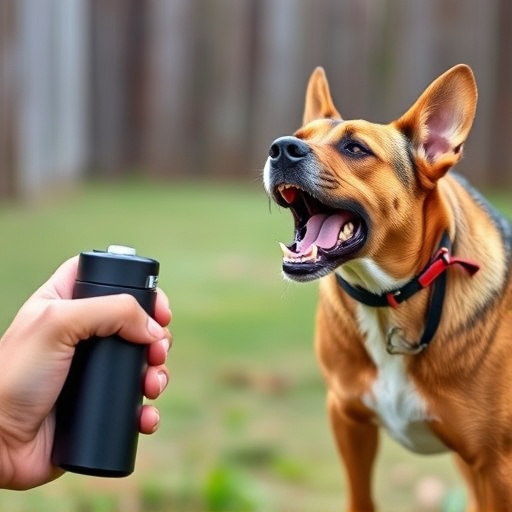Using pepper spray (OC) against aggressive dogs can be effective, but immediate and thorough decontamination is crucial. After exposure, rinse your pet's face, mouth, paws, and affected areas with abundant water. Severe symptoms like persistent coughing or breathing difficulties require veterinary care. This process ensures the safety of both your pet and others, emphasizing responsible pepper spray use: always decontaminate your pet after Mace exposure.
“Unleashing Protection: Mastering Pepper Spray for Aggressive Dogs offers a non-lethal solution to canine aggression. This comprehensive guide explores the power of pepper spray, its immediate effects on dogs, and responsible usage.
Learn when and how to deploy this tool effectively while ensuring safe handling. Discover crucial post-exposure care, particularly focusing on decontaminating your pet after Mace contact, for a complete approach to managing aggressive behavior.”
- Understanding Pepper Spray and Its Effects on Dogs
- When to Use Pepper Spray on Aggressive Canines
- Safe Handling and Application Techniques
- Post-Exposure Care: Decontaminating Your Pet After Mace Contact
Understanding Pepper Spray and Its Effects on Dogs
Pepper spray, also known as oleoresin capsicum (OC), is a non-lethal self-defense agent that works by causing a burning sensation and temporary blindness in the eyes and respiratory system of the target. When used appropriately, it can be an effective tool to deter aggressive dog encounters. However, understanding its effects on dogs is crucial for safe and responsible use.
After exposure to pepper spray, decontaminating your pet becomes essential. This process involves rinsing their face, mouth, paws, and any other affected areas with plenty of water. It’s recommended to seek veterinary care if the dog shows severe symptoms like persistent coughing, difficulty breathing, or excessive drooling. Proper decontamination ensures the safety and well-being of both the pet and those around them, making it a vital step in managing potential risks associated with pepper spray use.
When to Use Pepper Spray on Aggressive Canines
When faced with an aggressive dog, knowing when to deploy pepper spray can be a life-saving decision. It’s most effective in situations where traditional training and commands are ineffective or when dealing with unpredictable, highly charged dogs that pose an immediate threat. Pepper spray can deter and temporarily incapacitate an aggressive canine, allowing you or others nearby time to escape to safety.
After using pepper spray on an aggressive dog, it’s crucial to decontaminate your pet as soon as possible. This involves thoroughly washing their face, paws, and any other affected areas with warm water and mild soap to remove the irritant. It’s important to follow up by offering comfort and soothing measures to ensure your pet doesn’t associate the scent or experience with a negative interaction.
Safe Handling and Application Techniques
When using pepper spray on aggressive dogs, safety is paramount. Always wear protective gear, including gloves and eye protection, to prevent direct contact with the spray. Ensure the area is well-ventilated to minimize inhalation of the irritant. After deployment, promptly decontaminate both the dog and yourself by washing affected areas with warm water and mild soap. Pay special attention to the face, paws, and any other sensitive areas.
For effective application, maintain a safe distance and aim for the dog’s face and eyes. Use quick, short bursts rather than prolonged sprays. Be prepared to move quickly if the dog charges. Never point the spray directly at the dog, as it can cause severe eye damage. After exposure, monitor the dog for any adverse reactions and seek veterinary care if necessary, especially for persistent coughing or breathing difficulties.
Post-Exposure Care: Decontaminating Your Pet After Mace Contact
After a dog has been exposed to pepper spray, proper post-exposure care is crucial to ensure your pet’s safety and comfort. The first step in decontaminating your pet after mace contact is to immediately rinse the affected areas with plenty of water. This helps dilute the pepper spray residue and alleviate any discomfort or irritation. Be sure to flush eyes, nose, and mouth thoroughly, as these areas are particularly sensitive to the irritants in pepper spray.
Once rinsed, gently wipe your pet’s fur with a soft, damp cloth to remove any remaining spray. Pay special attention to the face, paws, and any other areas where the spray may have been absorbed or concentrated. Avoid using harsh soaps or cleaning agents, as these can further irritate the skin. If possible, seek veterinary care for a thorough examination, especially if your pet shows signs of distress, difficulty breathing, or excessive drooling. The vet may recommend additional decontamination measures tailored to your pet’s specific needs.
Pepper spray can be a valuable tool for managing aggressive dog behavior, but its responsible use and proper decontamination after exposure are crucial. By understanding the effects of pepper spray on dogs and mastering safe handling techniques, pet owners can effectively navigate challenging situations while ensuring their safety and that of their pets. Always remember to decontaminate your pet thoroughly after any Mace contact to prevent potential irritation or discomfort.
